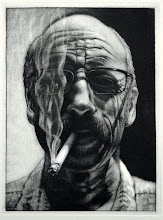When we finally focused on the project of the day, only one person had an idea ready to roll. So I went through the whole process, how to use the exposure unit, and exposed the plate to the aquatint screen and the transparency, developed/etched, and then proofed the plate. Everything showed up in the proof, but the dense blacks had light areas. I had printed another transparency and layered it one on top of the other, and as Rob pointed out to me, the density of the layered blacks had blocked each other out thus producing an area that didn't have enough tooth to hold the ink. That made all kinds of sense. Good thinking , Rob.
I'm going to try combining the various over exposed plates into a separation image and see if there's anything there. If not, I'll look for another alternative. Anthony has an image ready to go that's pretty nice, so I guess he'll attack that this weekend. Everyone else got solar plates and we'll see what happens with them. We'll look at collagraphs on Monday.
So, when do you want to do a print-a-thon?

4 comments:
Not having a drawing ready should not be taken as a lack of interest. I AM excited about working with the solarplate. I just want to be sure I have an image that's good enough to print since there are no do-overs after the plate is exposed.
Although there'll be as many do-overs as we have plates, so if one or two or three don't go well, we have a few more plates to work with.
Good to know. Thanks for clarifying.
brian, Thank you for mentioning my panel "Classical Practices in the Digital Age" for the great conference in Fargo.
Check out my blog: http://kuklawatercolor.blogspot.com/
Happy Thanksgiving holiday! Hope you got a lot of work done! Cynthia
Post a Comment